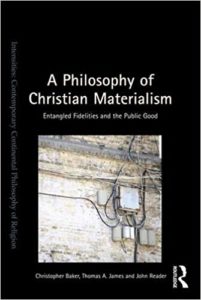Christian Materialism?
I was recently asked by Reading Religion to review an intriguing book called A Philosophy of Christian Materialism. I’m sharing my review here, because the book, while technical, prompts insights and new reflection.
Overview
In this contribution to the Routledge Contemporary Continental Philosophy of Religion series, three authors construct a philosophy of Christian materialism that addresses lived experience. In doing so, they draw upon figures and themes in continental philosophy. Their goal is a new version of relational Christian realism that emphasizes deep connection and entangled fidelities.
A recurring theme in A Philosophy of Christian Materialism: Entangled Fidelities and the Public Good is the endeavor to overcome the transcendent-immanent dualism prevalent in Christian theology. This theological vision seeks to set aside transcendence and stay within the immanent plane.
The authors reject both an entirely secular vision of existence and classic Christianity (especially Radical Orthodoxy). Their alternative draws from Christian realism, but it uses new categories, new theology, and new philosophical ontologies. The primary philosophical resources for this alternative are Gilles Deleuze, Bruno Latour, and Alain Badiou.
After a chapters laying out method, the authors get to their primary claims. They consider religion, generally speaking, a fidelity that engages material loyalties and commitments within the social, economic, and political spheres. As such, religion requires no transcendent, extramundane reality; it calls our attention to what is near. Religious orienting is always fluid, not definitively given by one person or one community.
Given their aversion for a transcendent God, the authors work to articulate language for their alternative. The God they describe is not an outside agent imposing purposes upon the material world. God is an immanent power within the cosmos, but not identical with it.
Hidden within the realities and actualities of existence are “virtual” powers. This virtuality is God; but God is also the ungroundedness of existence. God is “not as an actual being,” they explain, “but in some way virtual: as a power or powers that are somehow hidden within the actual, along the same plane of immanence with them but not among them as one actuality among others” (92). Among other things, this means God has no unity.
Moving from their characterization of God, the authors address briefly key Christian figures and themes. For instance, this vision regards Jesus a happening quantitatively more powerful than most happenings. He creates a higher than usual number of productive links between objects or elements within the plane of immanence. Jesus unsettles the actual and mobilizes the volcanic powers of the virtual (God). But the only way Christ can leverage power within the world is through alliance with other actualities.
These authors reject the idea creation is a static order God set in place long ago. Rather, creation is an enclosed but inclusive domain characterized by flexible ordering. From it emerges possible meanings and values. Creation so conceived is good, corrupt, and renewable: an ongoing gift.
Humans in this theological vision find themselves entangled in multiple fidelities, within which they encounter God. Those who gather as the people of God imagine new ways of bringing being into actual reality. As expressions of the restless God, humans are also restless. This restlessness implies an eschatological vision with no final beatific end for humans, Earth, or the universe.
The authors address briefly other themes of Christian theology such as fall, sin, redemption, imago dei, and more. Of particular note is that relational Christian realism affirms a cosmic, nonanthropocentric vision of redemption. This redemption is contingent upon the various ways in which divine virtuality is expressed amid the interplay of actual things in the world. But redemption is stubbornly contingent.
The final three chapters of the book address issues of practical engagement in the public sphere. Relational Christian realism engages the tangled fidelities of actual existence, say the authors, and thereby contributes to public life. Chapters address radical hospitality, equal distribution and flow of power, attractions, and the reassembling of the public commonwealth. Case studies and examples abound, addressing in particular urban community empowerment, education, and environmental issues.
The final chapter offers brief reflections on political implications for relational Christian realism. The hope envisioned here is not based upon a God who serves as an organizing center of power. Instead, this God is the virtuality expressed within the entangled fidelities of existence.
Evaluation
A Philosophy of Christian Materialism offers an intriguing theological vision. The authors rightly identify weaknesses in earlier forms of Christian realism and flaws in Radical Orthodoxy. They draw from Continental resources not often mined by Christian theologians, while being informed by open and relational thinking characteristic of the Whiteheadian tradition.
But in my view, the book tries to do too much. The authors rightly see the value of explaining the method, theological vision, and practical implications of their new perspective. But this probably should have been three books, not one. Readers will feel sharp shifts between the book’s sections, and the writing and rhetoric varies widely.
I was especially intrigued by what “relational” means for this form of Christian realism. And I was intrigued by the authors’ disdain for “transcendence.” Unfortunately, I found no clear definition of what they mean by divine transcendence. But enough phrases led me to think the authors were rejecting the view of a God essentially disconnected from existence. I find this helpful, and I find helpful their emphasis upon an immanent God entangled within actualities.
I wondered, however, how this God is “relational,” if not in any sense transcendent or “other?” I also find problematic some views of transcendence in traditional versions of Christianity. But are these authors implicitly advocating pantheism? They explicitly appeal to panentheism in a short section, but panentheism requires some aspects of divine transcendence.
In sum, this important book requires follow-up to explain and develop its themes. The alternative theological vision it sketches seems like a needed alternative for our day, but we need further elaboration.

Comments